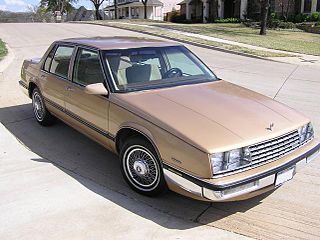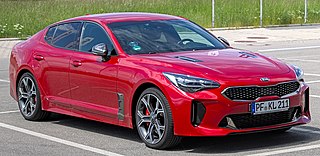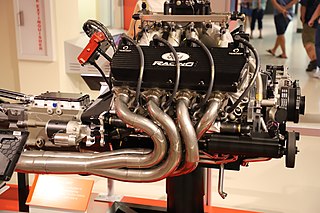
The Nissan Z-series is a model series of sports cars manufactured by Nissan since 1969.

The Porsche 996 is the fifth generation of the 911 model sports car manufactured by the German automaker Porsche from 1997 until 2006. It was replaced by the 997 in 2004, but the high performance Turbo S, GT2 and GT3 variants remained in production until 2006. The 996 had little in common with its predecessor, with the first all new chassis platform since the original 911 and a new water-cooled engine. Technically, it was a major change, a complete break from the original car other than the overall layout.

The Buick Skyhawk is an automobile produced by Buick in two generations for the 1975 through 1989 model years.

The Iron Duke engine is a 151 cu in (2.5 L) straight-4 piston engine built by the Pontiac Motor Division of General Motors from 1977 until 1993. Originally developed as Pontiac's new economy car engine, it was used in a wide variety of vehicles across GM's lineup in the 1980s as well as supplied to American Motors Corporation (AMC). The engine was engineered for fuel efficiency, smooth operation, and long life, not for performance. Total Duke engine production is estimated to be between 3.8 and 4.2 million units.

The Oldsmobile 4-4-2 is a muscle car produced by Oldsmobile between the 1964 and 1987 model years. Introduced as an option package for US-sold F-85 and Cutlass models, it became a model in its own right from 1968 to 1971, spawned the Hurst/Olds in 1968, then reverted to an option through the mid-1970s. The name was revived in the 1980s on the rear-wheel drive Cutlass Supreme and early 1990s as an option package for the new front-wheel drive Cutlass Calais.

The Quad 4 is a family of straight-four engines produced by General Motors' Oldsmobile division. Several double overhead camshaft (DOHC) versions were produced between 1987 and 2002, and one single overhead camshaft (SOHC) model was built from 1992 to 1994.

The Oldsmobile Achieva is a front-wheel drive compact sedan and coupe that was introduced by Oldsmobile for the 1992 model year. The Achieva was based on the GM N-body platform, which it also shared with its siblings the Pontiac Grand Am and Buick Skylark. The Achieva replaced the GM N-body Cutlass Calais after its final 1991 model year, and ended production after the 1998 model year.

The Kia K5, formerly known as the Kia Optima, is a mid-size car manufactured by Kia since 2000 and marketed globally through various nameplates. First generation cars were mostly marketed as the Optima, although the Kia Magentis name was used in Europe and Canada when sales began there in 2002. For the second-generation models, Kia used the Kia Lotze and Kia K5 name for the South Korean market, and the Magentis name globally, except in the United States, Canada, Malaysia and the Middle East, where the Optima name was retained until the 2021 model year. The K5 name is used for all markets since the introduction of the fifth generation in 2019.

The Hyundai Tiburon, known in Europe as the Hyundai Coupé, is a sports coupe that was produced by the South Korean manufacturer Hyundai from 1996 to 2008.

Alpina Burkard Bovensiepen GmbH & Co. KG is an automobile manufacturing company based in Buchloe, in the Ostallgäu district of Bavaria, Germany that develops and sells high-performance versions of BMW cars. Alpina works closely with BMW and their processes are integrated into BMW's production lines, and is recognized by the German Ministry of Transport as an automobile manufacturer, in contrast to other performance specialists, which are aftermarket tuners. The Alpina B7 is produced at the same assembly line in Dingolfing, Germany, as BMW's own 7 Series. The B7's twin-turbo 4.4-litre V8 is assembled by hand at Alpina's facility in Buchloe, Germany, before being shipped to BMW for installation, and the assembled vehicle is then sent back to Alpina for finishing touches.

The Ruf CTR also known as the CTR Yellowbird or simply Yellowbird, is a limited-production, high performance sports car manufactured by German automobile manufacturer Ruf Automobile. Introduced for the 1987 model year and based on the Porsche 911, the CTR featured an enlarged and highly tuned version of Porsche's 3.2 litre flat-six cylinder engine, lightened body panels, an integrated roll cage, upgraded suspension and braking systems, a custom-designed transmission, and several unique trim pieces such as polyurethane bumpers, and the use of the side-mounted oil filler necessitated by relocating the oil tank forward to clear the intercooler on that side.

The H platform, or H-body designates a General Motors front-wheel-drive full-sized car platform introduced in 1986, and in most respects identical to the front-drive C platform introduced for model year 1985. Originally available in both 2-door and 4-door versions — the latter was more popular and two-door models dropped by 1992. Engines were predominantly the Buick's 3.8 liter V6 engine and later, GM's Buick 3800 V6; in naturally aspirated and supercharged variants.

The Smart Forfour is a city car (A-segment) marketed by Smart over two generations. The first generation was marketed in Europe from 2004 to 2006 with a front-engine configuration, sharing its platform with the Mitsubishi Colt. The second generation was marketed in Europe from 2014 after an eight-year hiatus, using rear-engine or rear electric motor configurations. It is based on the third-generation Renault Twingo, which also forms a basis for the third-generation Smart Fortwo. A battery electric version was marketed as the EQ Forfour beginning in 2018.

The Porsche 911 GT2 is a high-performance, track-focused sports car built by the German automobile manufacturer Porsche from 1993 to 2009, and then since 2010 as the GT2 RS. It is based on the 911 Turbo, and uses a similar twin-turbocharged engine, but features numerous upgrades, including engine enhancements, larger brakes, and stiffer suspension calibration. The GT2 is significantly lighter than the Turbo due to its use of rear-wheel-drive instead of an all-wheel-drive system and the reduction or removal of interior components. As a result, the GT2 is the most expensive and fastest model among the 911 lineup.
Hennessey Performance Engineering (HPE) is an American hypercar manufacturer and high-performance vehicle creator.

The Kia Stinger is a mid-size liftback/fastback manufactured by Kia between 2017 and 2023.

The Changan CS75 is a compact crossover SUV produced by Changan Automobile. Debuted during the 2013 Guangzhou Auto Show and launched on the Chinese auto market in 2014, the original Changan CS75 received a facelift in 2018 and an additional PHEV model in the same year. The Changan CS75 Plus debuted on the 2019 Shanghai Auto Show and was launched on the Chinese auto market in 2019 while the original CS75 model remains in production and on the market. As of November 2020, the "Millionth Edition" first generation CS75 based on the 2018 facelift model was announced. The second generation CS75 Plus was introduced for the 2022 model year with updated powertrain and revised design.

The Devel Sixteen is a mid-engine track-only sports car designed in the United Arab Emirates by Devel Motors. Devel Motors claims the V16 quad-turbo version of the car to be the fastest car in the world, with a claimed top speed of 348 mph (560 km/h) and a claimed 0–60 mph time of 1.8 seconds; its announced base version price is $1.7 million.

NASCAR, the highest governing body and top level division for stock car racing in the United States, has used a range of different types of engine configurations and displacements since its inaugural season in 1949. The engines are currently used in the Cup Series, Xfinity Series, Camping World Truck Series, and the Whelen Modified Tour.

Bugatti made two V-12 internal combustion piston engines. The first was a quad-turbocharged, 3.5-liter engine, used in their EB 110 sports car, in 1991. The second was a 6.0-liter, naturally-aspirated unit, used in their full-size EB 112 luxury fastback sedan.





















